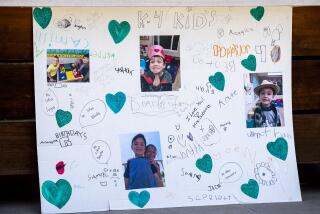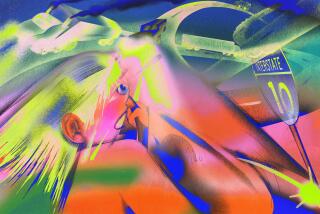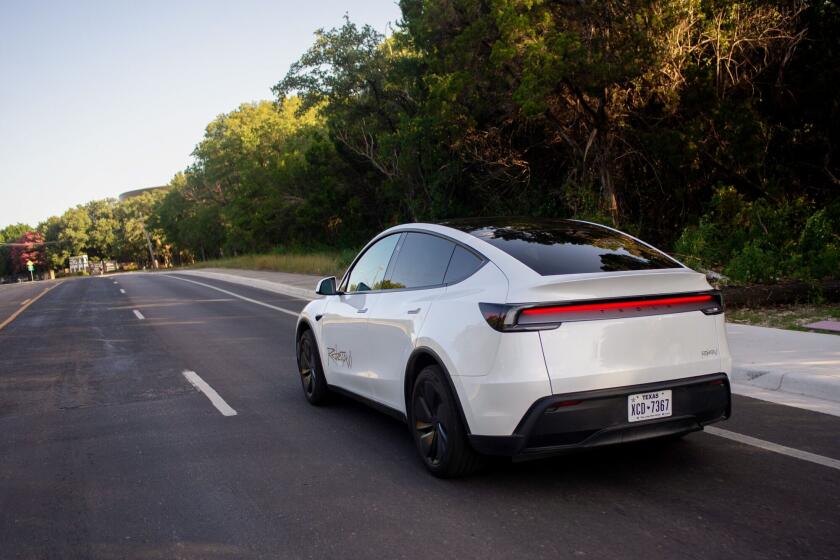Don’t Think and Drive
- Share via
Don’t you love it when someone announces research results that validate a seemingly freakish personal experience?
Several years ago, when I had an hourlong commute to a job I was planning to leave, I amused myself en route by making various mental computations. How many months, I wondered, could I live on my accrued vacation pay before my new business got up to speed?
I’d visualize a long list of my monthly expenditures and try to add up each column. Let’s see, that’s 37--put down 7, carry 3--added to, um . . . Omigod! Where did that car come from?
Lost in my long-range financial fog, I had nearly caused a nasty bit of short-term physical and financial damage. Somehow, the casual, peripheral awareness that most drivers think of as normal cruise control had drastically shut down.
After several days of near-misses, I began to realize that visualizing rows of numbers--or the design of my new business cards--was as much of a danger to me (and others) on the road as a couple of martinis. It got to the point that whenever I found myself woolgathering about my business plans, I had to force myself off the topic--or off the road.
When I mentioned this odd phenomenon to friends, they just rolled their eyes. After all, they were already acquainted with my baffled squint at any sign farther than a few feet away and my penchant for keeping an ocean of space between my car and the one ahead of me. And they could never fathom my inability to sustain any kind of coherent conversation while trying to merge in fast-flowing freeway traffic.
But now I have the last laugh.
A recent study published in the Journal of Experimental Psychology: Applied (https://www.apa.org/journals/xap/xap6131.html) indicates that thinking, particularly when it involves visualizing objects, is highly distracting to drivers.
Twelve people (seven women and five men, ages 21 to 37) took part in the experiment, which was conducted on roadways near Madrid. None of the 12 was familiar with the car (a Citroen BX-GTI, which the participants were allowed to take on a brief test drive) or the routes (which totaled 52 miles). All the tests were performed in daylight, in dry weather.
The car was equipped with an infrared video system that continuously tracked the participants’ eye movements as well as their view of the road. Drivers wore nothing on their heads--no goggles or helmets--that could potentially obscure their view.
While the participants drove, looking for signs directing them to their destination, an experimenter in the back seat guided them in two series of tasks. One was verbal: repeating groups of words that start with the same letter. The other was visual and spatial: imagining individual letters of the alphabet (either as stationary or rotating in space) in order to answer a series of questions. (As a control, the subjects also drove the same routes without performing any tasks.)
All but one of the participants said the verbal task was harder and made it more difficult for them to concentrate on the road. Yet both tasks caused the drivers’ pupils to dilate noticeably, indicating mental distraction. The participants’ eyes also tended to “freeze” more often--rather than scan the road--when the drivers were concentrating on visualizing objects.
But on a practical level, both types of tasks involved a marked decrease in driver attention to the car’s side and interior mirrors, as well as to the speedometer. At the same time, driving speeds did not decrease.
Skeptics might wonder whether the participants were unduly influenced by the unusual setup of the experiment. For that reason, they were asked to rate the similarity of their normal driving style to the one they demonstrated while performing the tasks. The average “similarity score”--admittedly a subjective rating--was 75 points out of a possible 100.
At the end of the study, coauthors Miguel A. Recarte, a psychologist at the Universidad Complutense in Madrid and Luis M. Nunes, a Spanish government psychologist specializing in driver research, posed several questions that still need to be answered.
They don’t claim to know, for example, how closely their experiment mimics the effects of drivers’ normal mental activities--such as doing mental calculations, trying to remember something or listening to sports on the radio. (And they don’t even bring up the question of whether drivers who are extremely familiar with their route--like benumbed commuters--are more or less likely to be dangerously distracted by their thoughts.)
*
Also, the psychologists don’t yet know whether people lost in thought simply do not detect what’s happening on the periphery of their visual field, or whether their diminished attention to the mirrors and the road involves weeding out information that actually is not crucial to road safety.
But the two psychologists cite other studies in making a couple of important points: A high percentage of car accidents appear to be due to lack of attention or information processing. And it’s entirely possible to “look but . . . not really see” when you’re stewing over personal problems or otherwise mentally engaged.
Arline Dillman, traffic safety manager for the Automobile Club of Southern California--herself the holder of a doctorate in educational psychology--had not read the lengthy study. But after hearing a brief synopsis, she said she thought more research is necessary to see “what it really means.”
“How, for example, do you compare the experience of drivers told to concentrate on something specific with that of drivers thinking their own thoughts?” Dillman asked. “And at what point does an experienced driver’s mind overload to the point that he or she is no longer concentrating on visual cues?
“Most people drive reasonably well most of the time. It’s the unexpected event and being able to cue into it that’s the central factor” in avoiding accidents.
“Telling people to concentrate on their driving,” Dillman said, “is something we do already.”
*
Still, the study helped me understand some puzzling and scary events from my own driving past.
Like the time I drove home from a Bay Area newspaper in the wee hours of a December morning after filing a review of “The Nutcracker.” To keep awake, I added my wobbly soprano to a cassette tape of Christmas carols. Lost in a holiday wonderland, only dimly aware that the tractor-trailer in front of me had abruptly pulled into the next lane, I plowed right into a car somebody had abandoned on the freeway.
Or the time I drove along a narrow road, carefully watching out for a bicyclist just behind me. As best I can recall, I started to think about how dangerous it was to pedal, unprotected, along a busy road. Perhaps I screened a little movie in my head about intrepid bikers boldly going where no one had gone before. Who knows?
But at some point, inexplicably and unconsciously, I started drifting over to the right. The next thing I knew, the bicyclist was shouting at me.
“I can’t believe you!” she yelled as she drew even with my car. “You turn your head to watch me, and then you drive right into my space!”
Stung by a mixture of horror, relief and embarrassment, I couldn’t bring myself to reply.
But now I’ve resolved to mend my ways. No more mental movies or sing-alongs, no more computations, no more pondering the great and small questions of life. Nope, I’m going to try to drive with nothing at all on my mind.
And talk about the last laugh: What if the infamous Southern California airhead turns out to be the safest driver on the road?
*
Cathy Curtis, a Los Angeles-based freelancer and former Times staff writer, last wrote for Highway 1 about car brochures. She can be reached at highway1@latimes.com.






